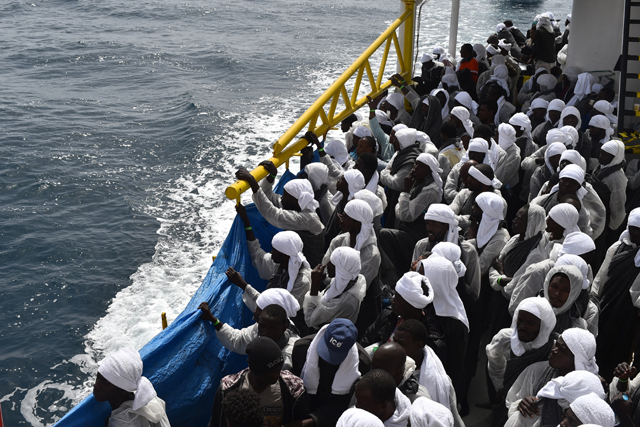
Palermo, Italy | AFP |
More than 1,000 migrants sang hymns, danced and clapped as they sailed into Palermo on Monday, along with the corpses of 17 people who did not survive another series of tragedy-tainted rescues in the Mediterranean.
Starting with the sick, women and children, several hundred of the mainly African group were disembarked from the Siem Pilot, a Norwegian ship working for the European borders agency Frontex’s Operation Triton.
In scenes being played out at a number of Italian ports after a busy weekend in waters off Libya, the rest were to stay on board overnight to ease the pressure on pier-side staff processing the new arrivals.
Among those arriving in Sicily were survivors of an incident on Friday morning when a rubber dinghy was attacked by men in a Libyan coastguard speedboat.
The attack, aimed at stealing or reclaiming the outboard engine of the dinghy, resulted in most of the passengers jumping into the water and the dinghy partially deflating. An unknown number, possibly as many as 25, drowned.
In a separate incident at least 10 people including four children drowned on Saturday morning during a rescue by the Doctors without Borders (MSF) charity’s boat, Dignity One.
Alhaji Kutubu Sankoh, from Sierra Leone, said the dinghy he had been travelling on had also had its engine taken off it by unknown assailants.
“We don’t know who has taken our machine. So we are on the water, everybody is crying, we just thought everything is over for us, but with God’s grace your people rescued us,” he told AFP.
Sankoh, 20, said he had left his home and begun the perilous journey over land and sea to Europe after his father died of Ebola.
“People stigmatise us so much, our family,” he said while admitting that he would not advise anyone else to make the same journey.
“I wouldn’t allow any of my family to use this road to be honest. It’s not easy, it’s very tough.”
An MSF psychological team waited on land to provide counselling for the survivors from the most traumatic incidents at sea. “Their stories give us nightmares,” the charity said in a Tweet.
Exhaustion and hunger were the most pressing concerns for most on the Siem Pilot.
Despite the fatigue, they were still able to raise a great cheer when informed by the crew that they were within an hour of the Sicilian port.
‘Too much pain’
Modoulamin Camara, 24, said he had left his native Gambia in July and travelled by car to Senegal, then by bus through the vast expanses of Mali and Niger.
“My brother then sent me money and I paid to go to Tripoli (the Libyan capital) in a pick-up truck with 26 other people,” he said.
In Tripoli he paid around $700 for the to get on the leaky boat with more than 150 other people.
“We suffered a lot, there were women in pain who had to be carried off. We left at 7am in the morning and were rescued at 5pm. I thank God I’m alive because too much pain,” he said.
“I was beaten from Niger to Libya. I want to stay in Italy. I’m a carpenter but my dream is to play football professionally. I’m really good!”
Buba Ceesaoi, 17, also described himself as a carpenter from the Gambia, said he had embarked on a boat after two months under the guard of Libyan former policemen in “a big hall” in the town of Sabratha.
“I started working at nine years old, but there is no work so I had to leave,” he said.
The latest arrivals to be processed lifted to more than 153,000 the total number landing in Italy in 2016 — equalling 2015’s full-year tally but still behind a total of around 170,000 registered in 2014.
While the numbers have remained broadly stable, the crossing has become more dangerous, with some 3,700 people known to have died in the Mediterranean this year, according to the UN, the bulk of them on the Italy-Libya route.
The number of unaccompanied children has also risen sharply and pressure has grown on Italy’s overwhelmed reception centres as a result of the country’s neighbours tightening their border controls.
 The Independent Uganda: You get the Truth we Pay the Price
The Independent Uganda: You get the Truth we Pay the Price



